India Indian music music vocalists: 78 rpm discs
by Warren
1 comment
Meta
SiteMeter
Brighter Planet
78 rpm Records of Indian Music: Bangri Geets by Sardar Bai
This disc was part of the collection of 78s I acquired in Udaipur in 2000. These songs would appear to be in the Bangri language, which is also known as Haryanvi.
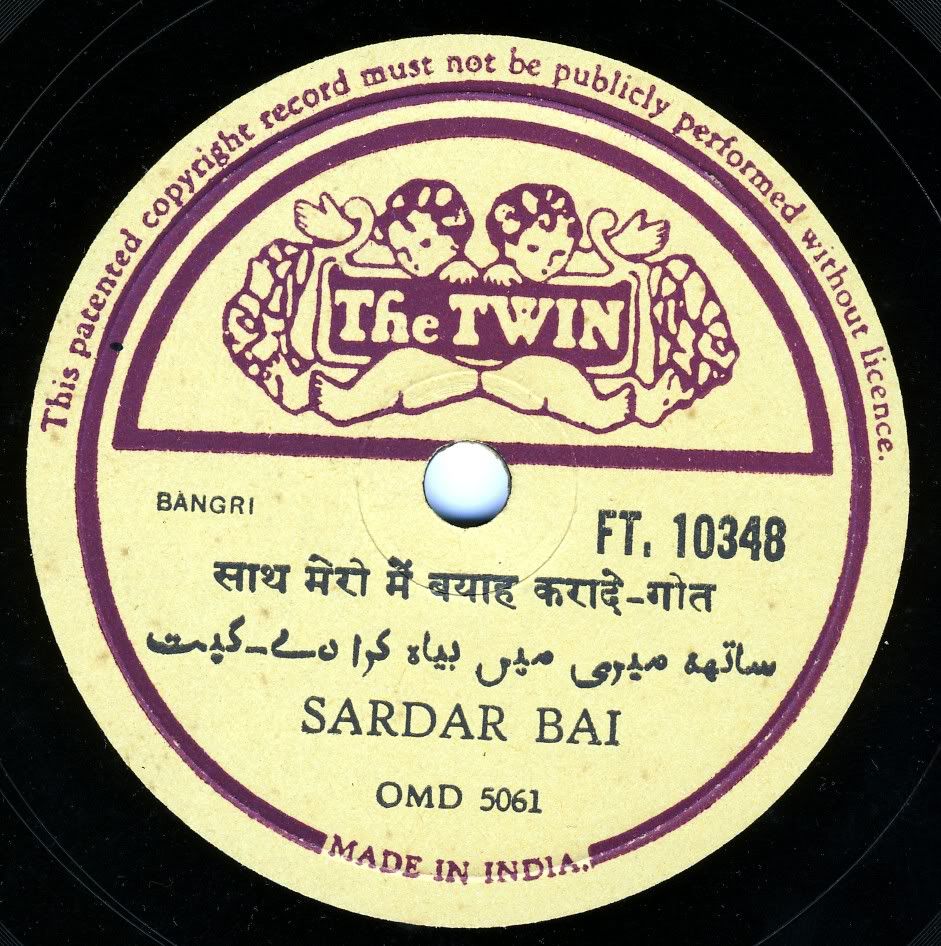
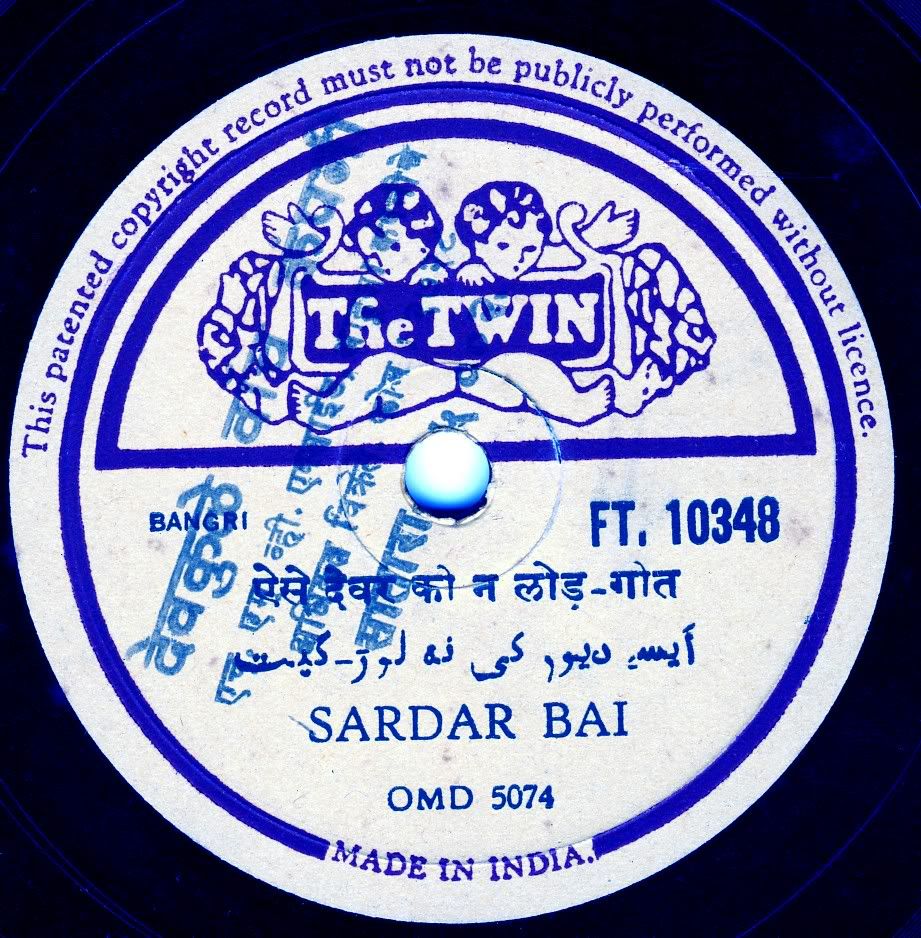
It is possible that this music is specific to the Bangri people, about whom little information is available beyond this:
The 5.7 million Bangri are located mainly in the states of Haryana, Karnataka, Himachal Pradesh, Uttar Pradesh, Punjab, and Delhi. Their language, Bangaru, is a member of the Indo-Aryan language family. Little is known about their specific lifestyle and culture.
Link
Irritatingly for my atheistic self, the site is that of PrayWay, a “global prayer community” that lists the Bangri among the world’s “unreached” peoples:
* People name: Bangri
* Country: India
* Their language: Bangaru
* Population:
(1990) 5,251,200
(1995) 5,776,500
(2000) 6,309,100
* Largest religion:
Hindu 98.4%
* Christians: 1.6%
* Church members: 92,425
* Scriptures in their own language: None
* Jesus Film in their own language: None
* Christian broadcasts in their own language: None
* Mission agencies working among this people: 2
* Persons who have heard the Gospel: 1,421,000 (25%)
Those evangelized by local Christians: 439,000 (8%)
Those evangelized from the outside: 982,000 (17%)
* Persons who have never heard the Gospel: 4,355,500 (75%)
Fortunately for us, there’s no need to convert these folks; let’s just listen to these two songs.
No information is available about Sardar Bai; there have been various well-known singers with that name in India’s recent history. I’m betting this isn’t one of them.
Saath Meri Men Bayaah Karaade
Aise Devar Ko Na Lod
India Indian music music vocalists: 78 rpm discs weirdness
by Warren
1 comment
Meta
SiteMeter
Brighter Planet
78 rpm Records of Indian Music: Hindustani Comic Song by Mr. Muradaly & Others
I have no information on “Mr. Muradaly and others.” But as I was pawing through a big stack of 78s in the middle of Chor Bazaar years ago, my eye was caught by this record.
How could I resist a “Hindustani Comic Song”?
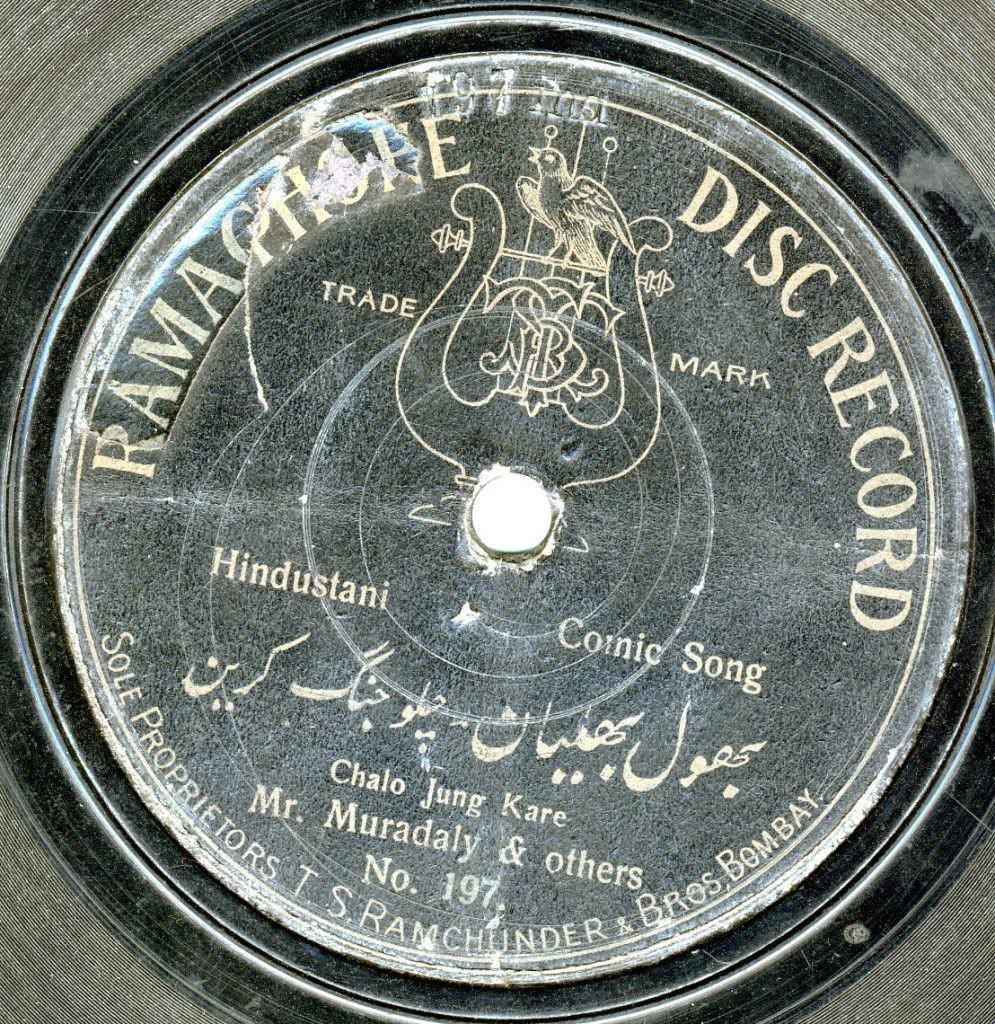
“Chalo Jung Kare” translates roughly as, “Come! Let’s go to war,” and indeed the military is clearly being lampooned, what with bugle calls and all. Do I detect some dialect humor?
Enjoy.
India Indian music music vocalists: 78 rpm discs genius
by Warren
8 comments
Meta
SiteMeter
Brighter Planet
78 rpm Records of Indian Music: Mr. Vishnupant Pagnis
Vishnupant Pagnis was one of the great voices of Marathi theater and early film. As these two recordings show, he was a hell of a singer.
Vishnupant Pagnis was an actor in Marathi theatre. At the age of 10 he joined Janubhau Nimkar`s Swadesh Hitachintak Natak Mandali in Kolhapur as an actor of female roles. His portrayals of Deval`s Sharada and Shakuntala in command performances for Shahu Maharaja won him popularity. He gained fame for creating the heroines of Warerkar`s first play Kunjavihari or `Wanderer in Gardens` in 1908 and Govindrao Tembe`s Shivraj Natak Mandali production in Hindi of Manishankar Trivedi`s Siddha-sansar or `Successful Life` in 1916.
The style of the celebrated Gujarati female impersonator, Jaishankar Sundari, is said to have influenced him. He appeared in Warerkar`s early silent film, Poona Raided in 1924. After his Sangitnatak career flagged, he taught music in a municipal school. A last-minute casting decision for the eponymous role in the successful movie Sant Tukaram or `Saint Tukaram` in 1936, he went on to play the lead in such“saint` films as Sant Tulsidas in 1939, Narsi Bhagat in 1940, and Mahatma Vidur in 1943, and grew famous as a Kirtan singer. He also headed a short-lived theatre company, Jagchhitradarshak Natak Mandali. Vishnupant Pagnis died in 1943.

He played the lead role in the film “biography” of the saint-poet Tukaram:
Sant Tukaram was also the subject of a biopic, title Sant Tukaram, made in 1936 by V. Damle and S. Fattelal of the Prabhat Film Company, starring Vishnupant Pagnis as the lead, and released on December 12, 1936 at the Central Cinema in Mumbai. The film was a big hit, and broke all previous records by running continuously for 57 weeks.[3] It also had won an award at the 5th Venice International Film Festival in 1937, and still remains a part of film appreciation courses.[4][5][6] It is preserved at the National Film Archive of India.[3]
Wiki
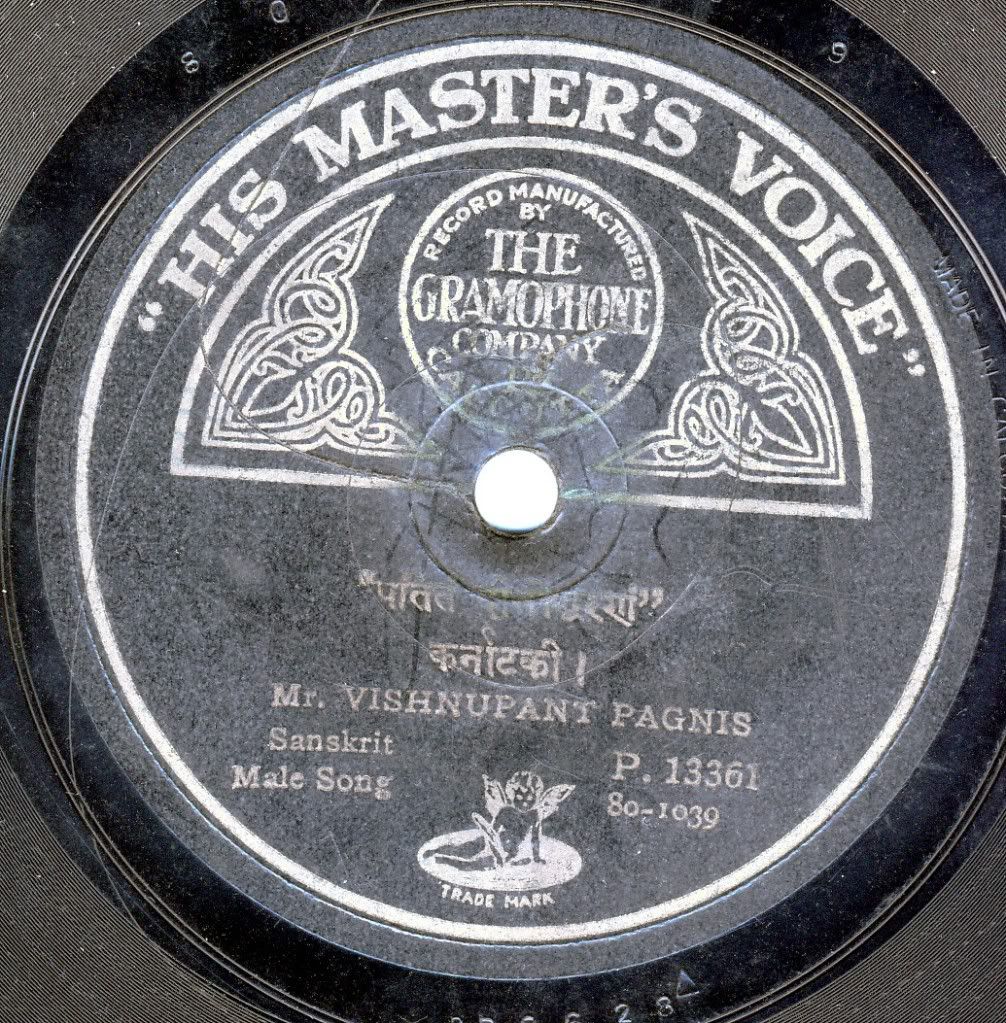
These two performances are from the early years of the twentieth century. The first is the celebrated patriotic song, Vande Mataram:
Vande Mataram (Devanagari: वन्दे मातरम्); Vande Mātaram “I bow to thee, Mother”) is a poem in the 1882 novel Anandamatha by Bankimchandra Chattopadhyay. It is written in a mixture of Bengali and Sanskrit.[1] It is a hymn to the goddess Durga, identified as the national personification of India. It came to be considered the “National Song of India”,[2] and it played a part in the Indian independence movement, first sung in a political context by Rabindranath Tagore at the 1896 session of the Indian National Congress.[3] In 1950, its first two verses were given the official status of “national song” of the Republic of India,[3] distinct from the national anthem of India Jana Gana Mana.
Wiki
Vande Mataram
And here is Patita Deenoduranan, a “Karnataki geet” in Sanskrit:
India Indian music music vocalists
by Warren
1 comment
Meta
SiteMeter
Brighter Planet
78 rpm Records of Indian Music: Mukul – “Haldi Ghaati”
Just the name Mukul.
This double-sided geet in Rajasthani sounds more like standard light-music performances, lacking the propulsive beat of traditional Rajasthani music. Damned if I know what “Haldi Ghaati” means.
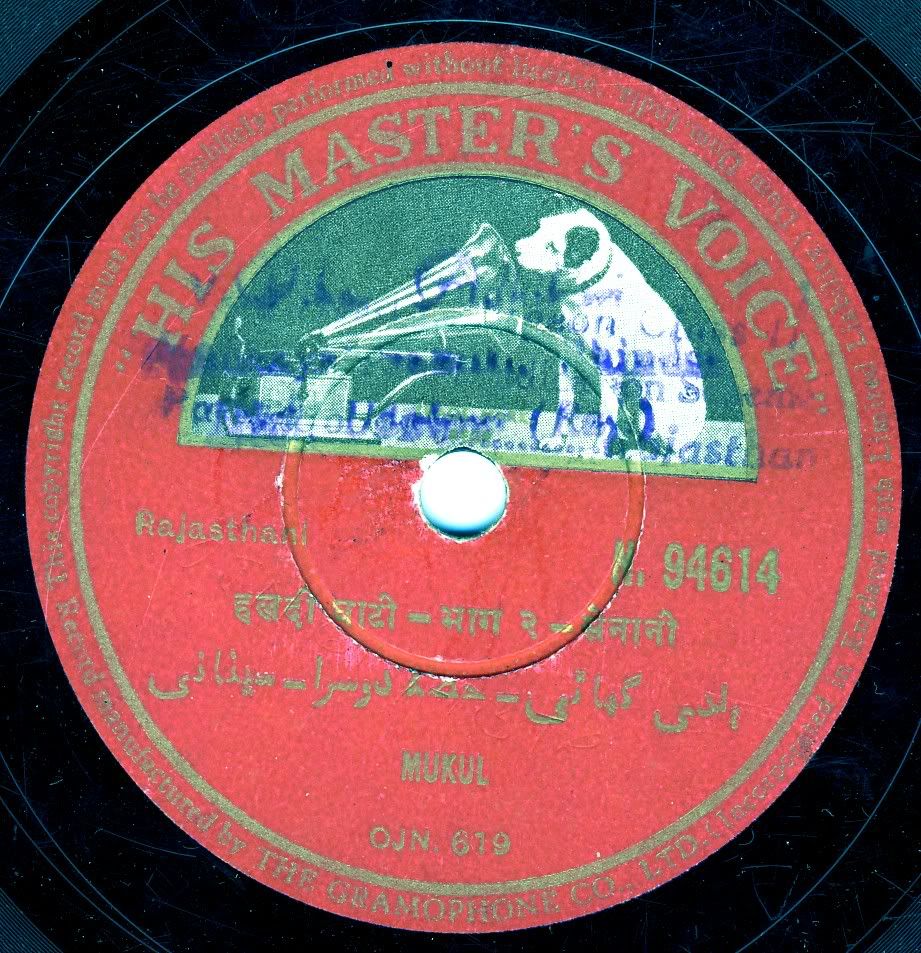
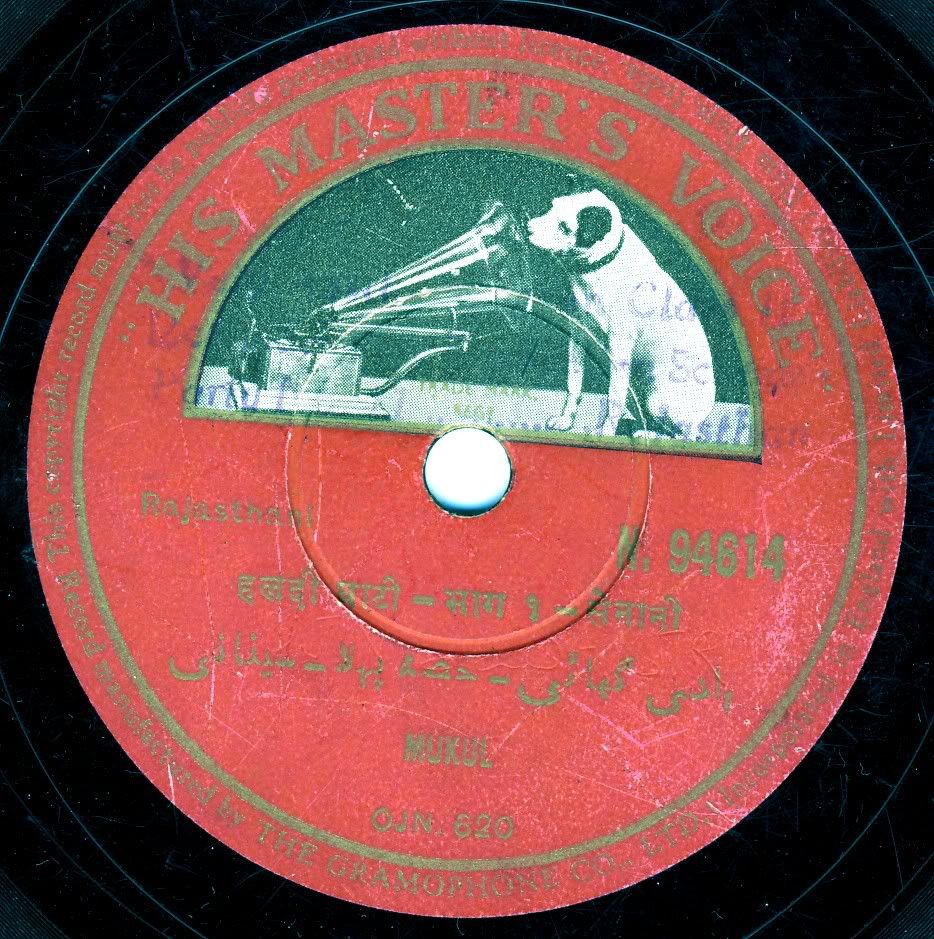
Haldi Ghaati
India Indian music music vocalists: 78 rpm discs
by Warren
2 comments
Meta
SiteMeter
Brighter Planet
78 rpm Records of Indian Music: Mr. Bhagoo of the New Alfred D. Company
Mr. Bhagoo, as the record label tells us, was one of the singers affiliated with the New Alfred D. Company, perhaps the most prominent theater group presenting Hindi and regional language drama at the beginning of the twentieth century.

His fine melismatic technique allows him to incorporate some tappa-ang taankari in this short performance.
Jake Chitme Chinta Buse
India Indian music music vocalists: 78 rpm discs
by Warren
1 comment
Meta
SiteMeter
Brighter Planet
78 rpm Records of Indian Music: The Twin Dramatic Party
This two-side-long piece is part of a drama in Urdu, based on the story of “Khosrow and Shirin”:
“Khosrow and Shirin” (Persian: خسرو و شیرین) is the title of several Persian epic poems. The essential narrative is a love story of Persian[1] origin, which is found in the great epico-historical poems of Shahnameh and which is based on historical figures that were elaborated and romanticized by later Persian poets. Variants of the story were also told under the titles “Khosrow and Farhad” and “Farhad and Shirin”.


Shirin Pharhaad
India music vocalists: 78 rpm discs
by Warren
1 comment
Meta
SiteMeter
Brighter Planet
78 rpm Records of Indian Music: Pandit Chand Narayan
No information is available about Pt. Chand Narayan. These two songs in Raga Bhairavi and Sindhu Bhairavi are beautiful performances with a pervasive ethos that rises up out of the swirling distortion and surface noise.

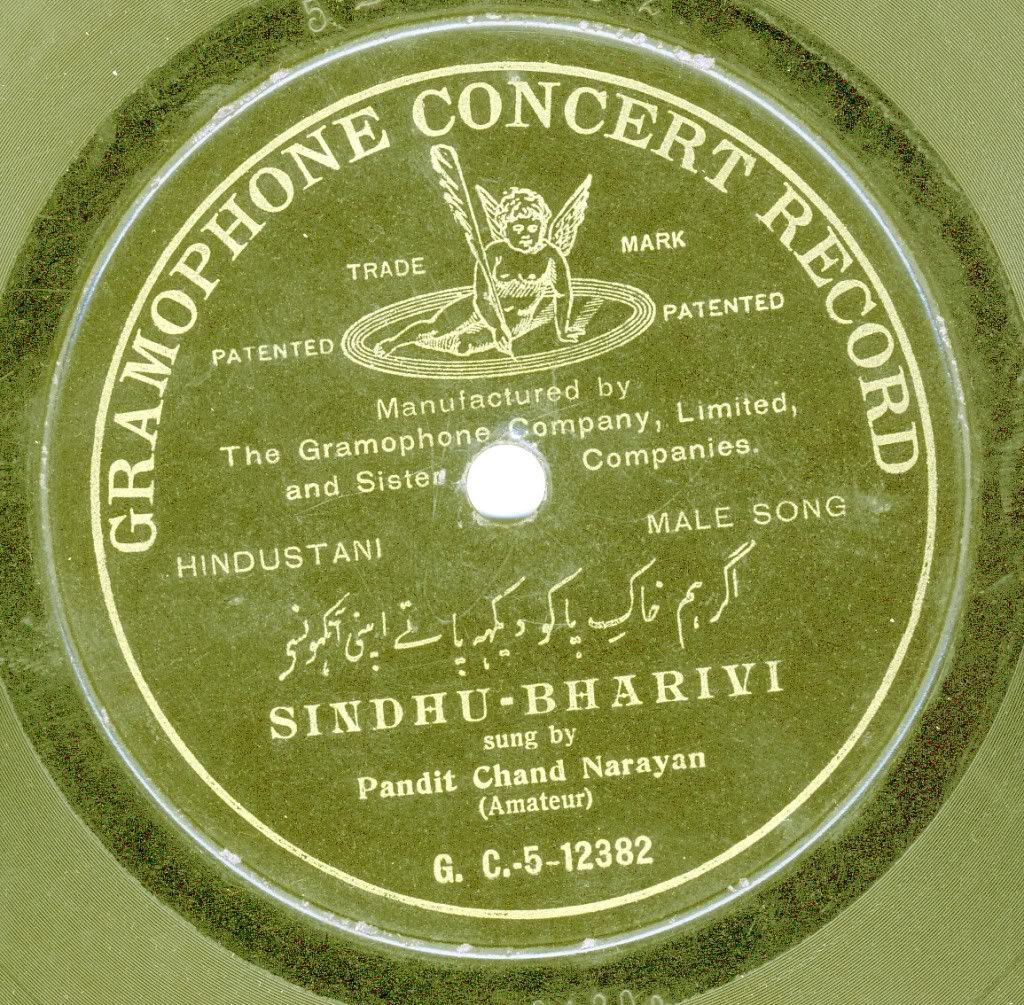
Ghazal in Raga Bhairavi
Raga Sindhu Bhairavi
India Indian music music vocalists: 78 rpm discs genius violin
by Warren
leave a comment
Meta
SiteMeter
Brighter Planet
78 rpm Records of Indian Music: Gajananrao Joshi’s Violin Virtuosity
The great Gajananrao Joshi. Both a violinist and a vocalist, he was one of the most competent and intelligent musicians of the century:
Wiki:
Joshi was a highly skilled violin player by the age of 20. His students include vocalist and violinist Madhukar Joshi, Vikas Kashalkar, Ulhas Kashalkar, Padma Talwalkar, and violinist Shridhar Parsekar. He also taught vocalists Kaushalya Manjeshwar, Shubhada Paradkar, Veena Sahasrabuddhe and Jayashree Patnekar. His daughter Malini, sons Manohar, Madhukar and Narayan are also trained musicians. His sons variously took to singing, violin, and tabla.
His grasp was so quick that it is said that Kesarbai Kerkar did not like to have him attend her concerts because he could quickly incorporate her strengths in his own singing. His gurus—father Anant Manohar Joshi of Gwalior, He was also a disciple of the late Pandit Balkrishnabau Vaze of the Gwalior Gharana Vilayat Hussein Khan of Agra and Bhurji Khan of Jaipur—spanned the three gharanas whose blend is exhibited in his art.
As the guru of my own guru, Pt. Devasthali, Gajananrao Joshi has a special place in my personal musical pantheon. Mohan Nadkarni’s biographical article on Gajananbua is well worth a read.
These two sides showcase his violin artistry, which was of a piece with his singing: intelligent, uncompromising, beautiful.
Listen and enjoy!
Raga Todi
Raga Kafi
India Indian music music vocalists: 78 rpm discs naat Quawwali Urdu
by Warren
3 comments
Meta
SiteMeter
Brighter Planet
78 rpm Records of Indian Music: Bashir Quaval of Poona
Unless I miss my guess, this still from the 1936 Hindi film Miss Frontier Mail (featuring Fearless Nadia!) is of Bashir Quaval playing harmonium and singing. He is featured on some songs in the movie, and the voice certainly sounds similar to these two naat-s. See the clip here.
Since much of India’s early film industry was based in Pune, the geographical suffix makes sense.
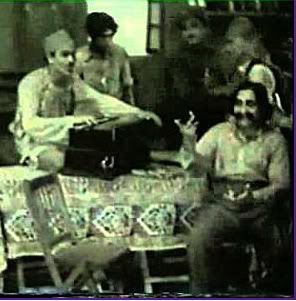
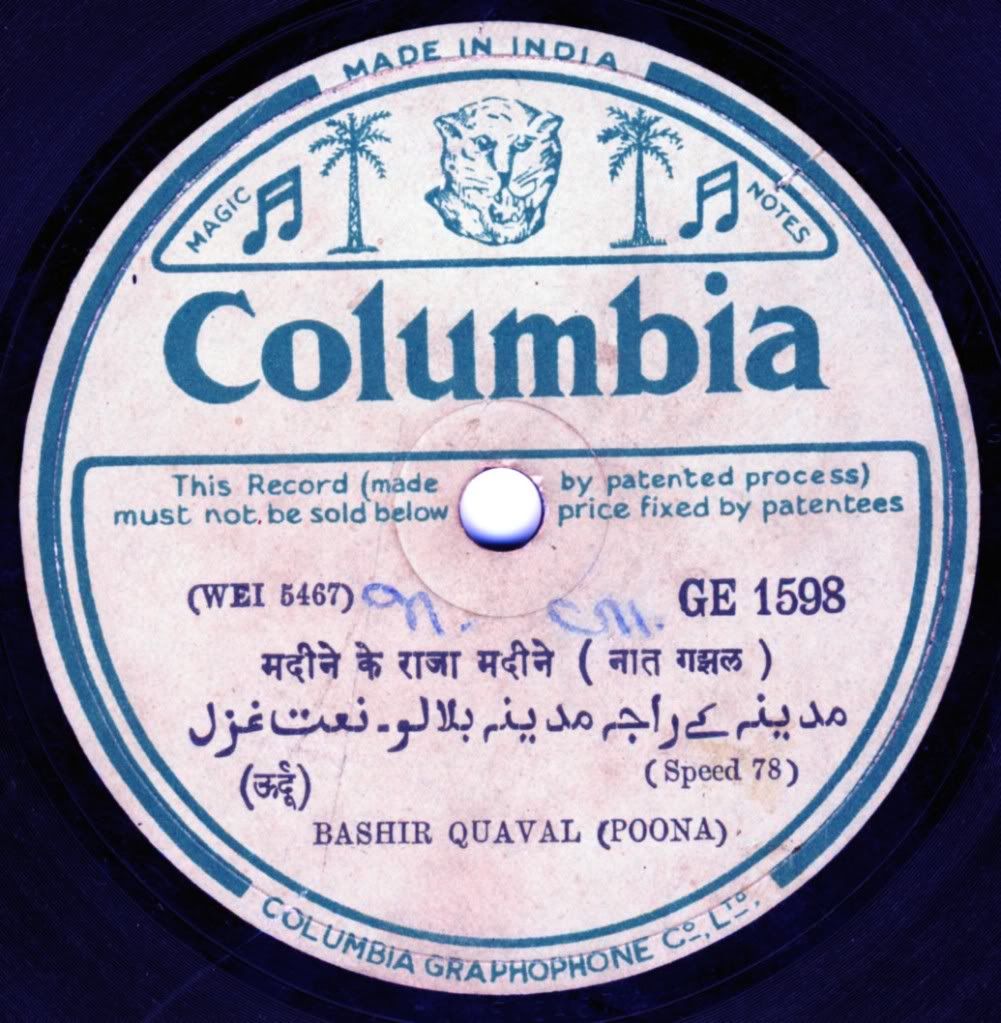
Madine ke raajaa madine
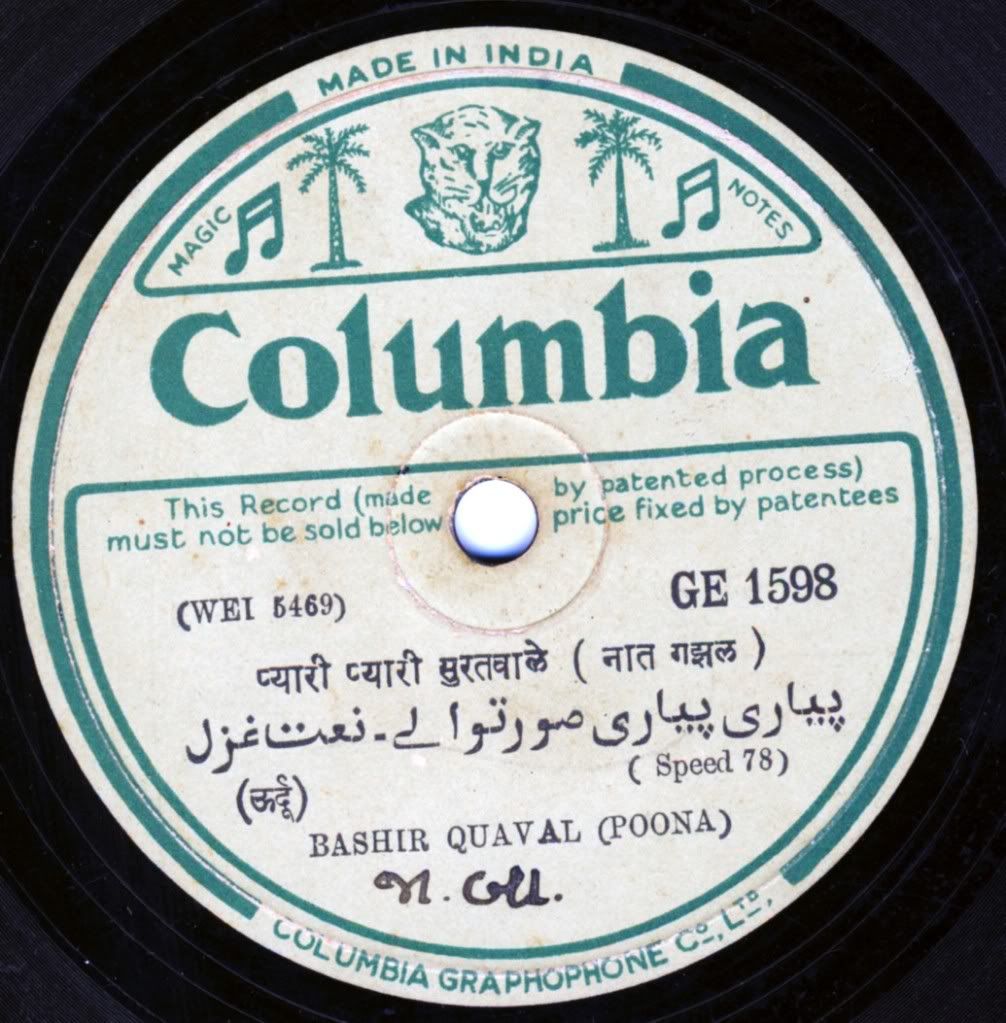
Pyaari pyaari suratwale
India Indian music music vocalists: Quawwali Urdu
by Warren
4 comments
Meta
SiteMeter
Brighter Planet
78 rpm Records of Indian Music: Wahidanbai of Agra
In Quawwali performances, a song in praise of the Prophet Mohammed is known as a naat. Wahidanbai of Agra was also heard in Hindi film around this time; unless I’ve got the wrong artist, she was sometimes known as Wahidan Wasti.
Regardless, I enjoy these two naats for her fervent delivery and clear voice production. You will, too.
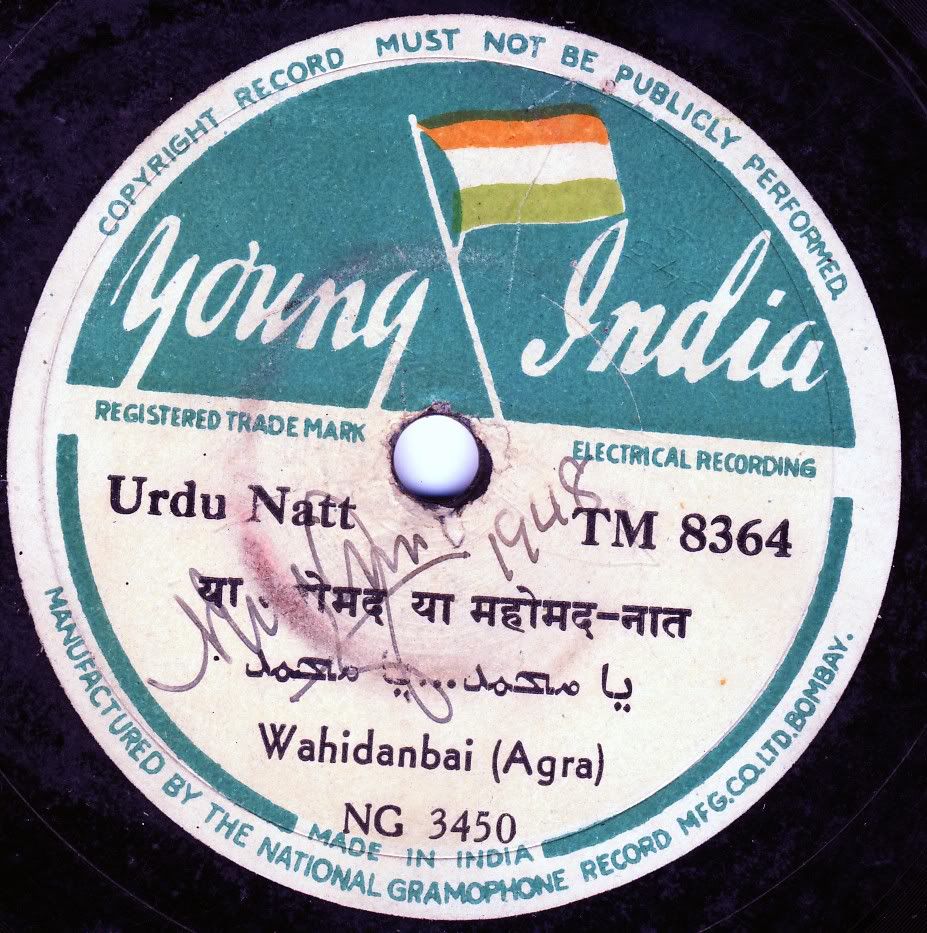
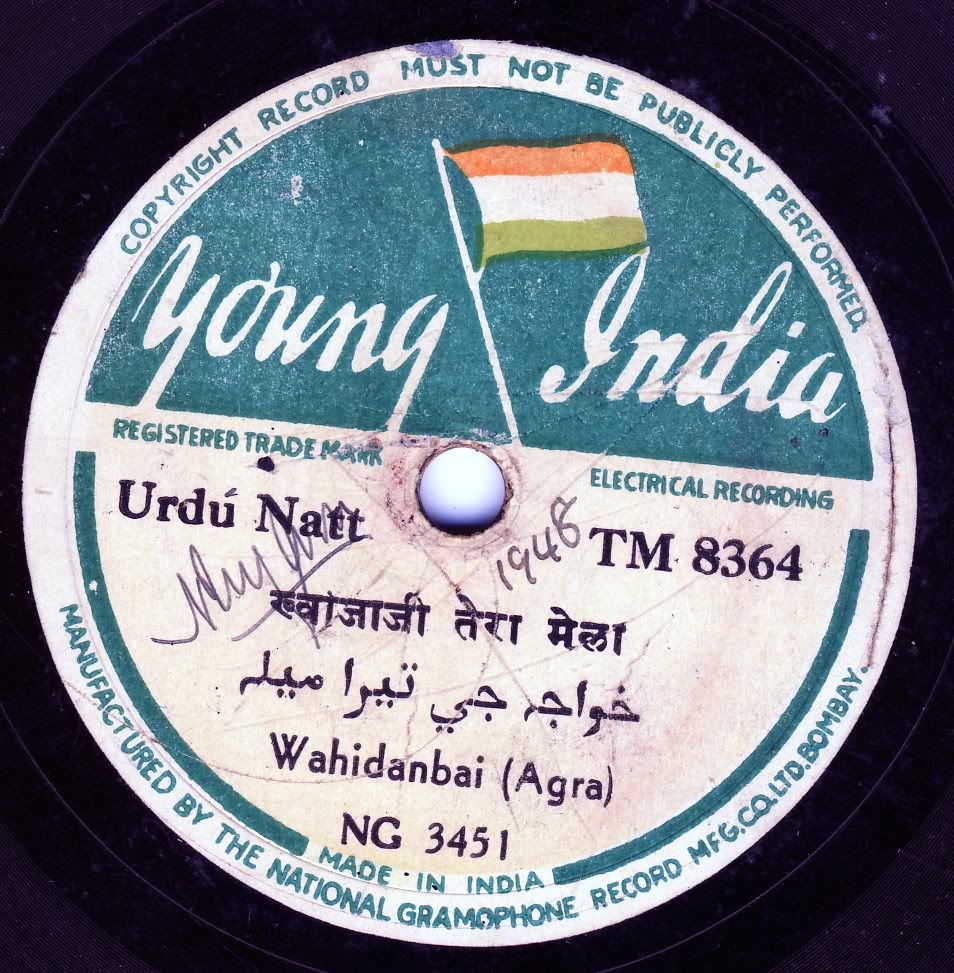
Ya Mohammed Ya Mohammed:
Khwaajaji tera mela:
The “Young India” record label was an attempt at indigenous music production:
During 1930-35, the British and German record manufacturing companies were well established and had a major share of disc manufacturing in India. The ‘Young India’ record label was an ‘indigenous’ effort at record production. The company issued over 10,000 songs on different subjects such as film music, classical music, folk music, publicity and educational material. Mainly amateur and upcoming artists have recorded on this label. The company ceased to function in 1955 so these recordings have never been reissued on audio tapes and CDs. Hence, it is important and relevant to preserve these invaluable recordings and the associated documents.
During 1935-55, the company produced over 10,000 titles on 78-rpm, 10 inch diameter shellac discs with two songs per disc. Each side could be played for over 3/3.5 minutes on spring wound gramophone machines. The recordings of film, popular, classical and folk music were issued. The repertoire covered music from different regions of India and sung in many different languages. During the long tenure of over twenty years, Indian citizens witnessed several important events such as the movement and struggle for freedom, Indian Independence in 1947, World War II and the beginning of the romantic period of independent India. This was also reflected in the records produced. Thus, there are speeches of great leaders, ballads, skits and dialogues on a number of subjects depicting changing social and political situations.

“Young India” records released many recordings of hortatory patriotic speeches. I wish I had a few of them in my collection, but these items are extremely rare.
